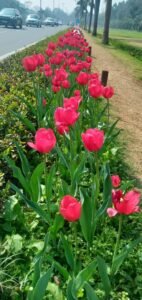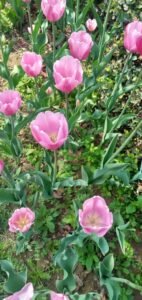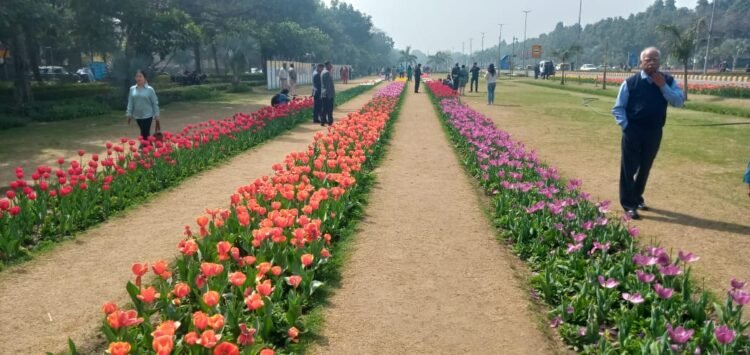No products in the cart.
FEBRUARY FLOWER POWER IN DELHI
Flower Festival at Delhi
Embassy Row, or Shantipath in New Delhi rarely encounters traffic jams. But guess what? It was all the fault of the tulips (Tulipa gesneriana L) — out in all their vibrant glory, lifting their heads to the benevolent sun and nodding their heads gently in the gentle breeze—and simply basking in all the attention they were getting from Dilliwallahs!

You couldn’t blame out-of-towners, receiving WhatsApp photos of the glorious blooms from Delhiites, thinking their friends or family members were sending them from Holland!
Delhi’s tryst with tulips is now becoming a long-term romance of many colours ranging from yellow, red, pink, orange, purple, white, and yellow painted with red streaks.
This year 300,000 bulbs were imported from the Netherlands; these were split between New Delhi Municipal Council (NDMC) and the Delhi Development Authority (DDA).
NDMC has judiciously planted them in strategic spots in the city including parks, gardens, roundabouts, sidewalks, etc. About 80,000 of these have found their way to various stretches of Shantipath, the venue for the city’s second Tulip Festival hosted by NDMC. This year the flower show has outshone the display put on in 2023.

The tulip blooms this year are not just confined to Lutyens Delhi. Citizens can enjoy them in other areas as well, including the Mehrauli Archaeological Park, Greater Kailash I, Vasant Vihar, AIIMS intersection, Dwarka, ISBT Kashmere Gate, Karampura-Rohtak Road, Shalimar Bagh, etc.,
Tulip Fever
It is believed that this exotic bloom “tulipan”, to the Turks, was introduced to Europe in the 16th century by the Ottomans who had been boldly expanding the footprint of their empire. The Flemish Ogier Ghiselin de Busbecq (1522–1592), ambassador of the Habsburg emperor in the Ottoman court in Istanbul in 1554–1562, was long acknowledged as the first to bring tulips to Europe. On the other hand, it could well have been the French diplomat and naturalist Pierre Belon (1517–1564) who could actually have been the first to bring oriental tulips to Europe. And so, the debate goes…
It may surprise many that tulips in Europe were prized more than gold. A single bulb could be worth as much as 4,000 or even 5,500 gold florins in Holland. The obsession with tulips became so huge that, as ascertained by the Library of Economics and Liberty, “it was deemed a proof of bad taste in any man of fortune to be without a collection of [tulips].” According to Scottish journalist Charles Mackay: “The wealthiest merchants to the poorest chimney sweeps jumped into the tulip fray, buying bulbs at high prices and selling them for even more.”

There came a time when things reached such a pitch, that when a handful of the rarest of rare blooms were traded at such unprecedented prices (for as much as six times the average person’s annual salary) it resulted in the famous Dutch market asset bubble and crash – the ‘Tulipomania’ of 1637. Tulips were being sold for around 10,000 guilders, at the value of a mansion on the Amsterdam Grand Canal. That notwithstanding the Netherlands is still the world’s biggest producer of tulips.
Get your hands on Anna Pavord ‘s ‘The Story of a Flower that Has Made Men Mad (1999)’, to delve deeper into this amazing story. Another good one to dig into is Dash, M. Tulipomania: The Story of the World’s Most Coveted Flower and the Extraordinary Passions it Aroused (Victor Gollancz/Orion Books Ltd., 1999).
The Fragrance of Floral Feasts
But our story is not just about Delhi’s love for tulips. This is about the feast of flowers the city enjoys almost till the end of March.

So, embedded between the tulips are other flowers such as petunias and pansies etc, which will start blooming when the tulips start fading away. The idea is to keep the floral adornment on display right through till the summer arrives. While stands of Salvia are slowly starting to bloom near the tulips, at the Mandi House roundabout, for example white, pink, and maroon dianthus will keep the show going.
The 66th Annual Flower Show on the Delhi University lawns is slated for March 1. To be held at Gautam Buddha Centenary Garden, Opposite Vice Chancellor’s Office its theme this year is Women Nurturing Nature, to celebrate synergy and sustainability.
Udyan Utsav 2024’ an exceptional treat in store awaits at Rashtrapati Bhavan at the Amrit Udayan (formerly the Mughal Garden). The annual flower show is on till March 31. Abandon yourself to the pleasures of this sensory journey amidst 100 varieties of roses, daffodils, Asiatic lilies, oriental lilies, and several rare seasonal blooms. Bal Vatika’, is a specially curated garden for children featuring the tale of a 225-year-old Sheesham tree, a nature classroom, and a tree house. Other key attractions include a theme garden featuring 42,000 tulips in 18 different varieties, the Bonsai Garden: with over 300 bonsais many of which are decades old, musical fountains, a floral clock, and gardens in wheelbarrows. Bookings can be made online at https://visit.rashtrapatibhavan.gov.in as well as through Self Service Kiosks placed outside Gate No. 35.
Beyond the Festivals
Delhi’s beautiful gardens are a riot of colours and fragrances in the spring. Unmissable spots to linger in — Sunder Nursery; Lodhi Gardens; Nehru Park Chanakyapuri; National Indo-Africa Friendship Rose Garden at the junction of Satya Marg and Shantipath; Garden of Five Senses, Saiyad ul Ajaib, Mehrauli; Deer Park, Hauz Khas; Buddha Jayanti Park; Japanese Garden/ Swarn Jayanti Park, Rohini;
















